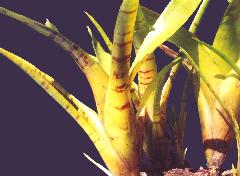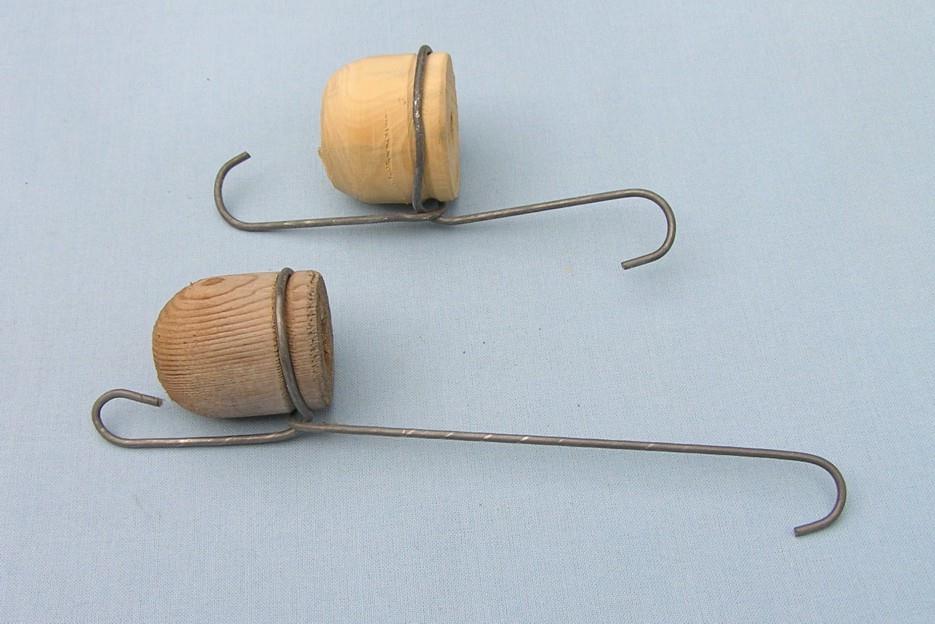
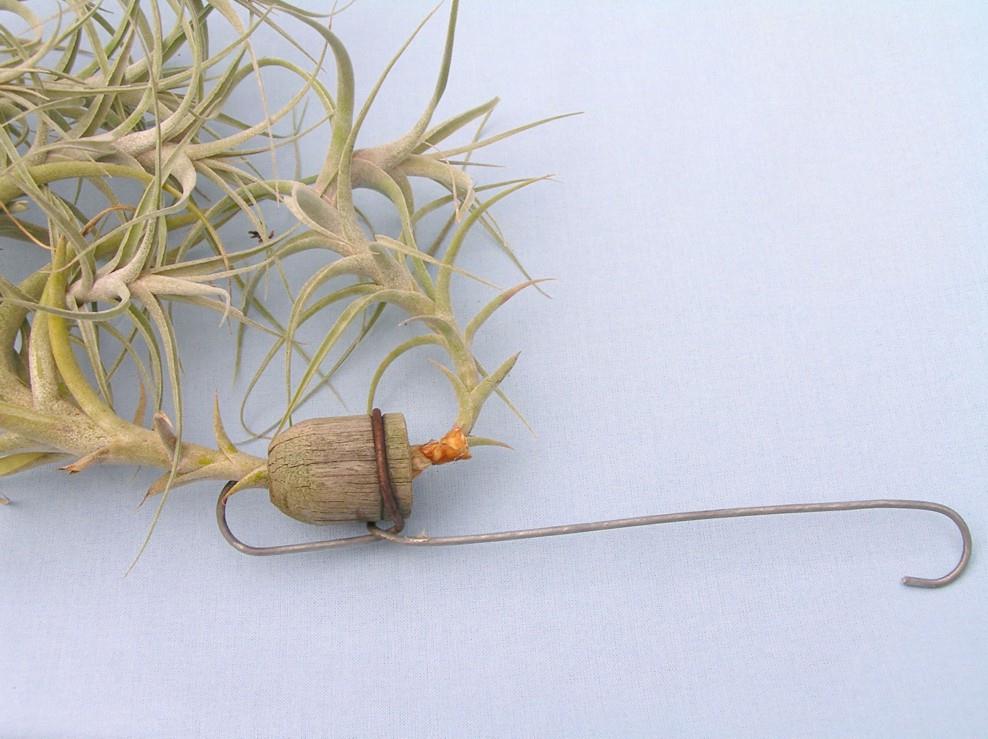
Click for larger image in new screen.
Coming Events.
November 11th 9am-4pm Plant Sale.
November 12th Offset swaps and Plant Auction.
Jan 14th Vrieseas with hieroglyphic markings on leaves.
September meeting from the Secretary’s desk.
It was good to see mention of Bromeliads in the latest ‘Our Gardens’ magazine which was handed out to interested members. Nina Rehak in Sydney was justly proud of her flowering Tillandsia cretacea. It was in a pot because it was too big to be mounted successfully.
We saved the best until last and let Len Colgan talk first on the plants brought in for the general display. There was a great flowering Billbergia sanderiana but the biggest surprise was to see 2 different Encholirium in spike. Usually big Len tells us all about identity of his tillandsias but was very quiet about these Encholirium he had got from Rudi Schultz in Victoria. Len likes prickly things which is in contrast to his tillandsias and tried to suggest (I think he did!) that they were so rare they had not been identified. In 2001 Rafaela Forzza wrote over 200 pages on Encholirium for her botanical doctorate. The trouble was that it was in Portuguese. However Margaret and I with the help of a computer translater - which does not seem to know botanical terms - converted it to English. We learnt that Rafaela must have been young when she started tramping the wilds of Brazil looking for prickly things. Now that Len has retired he will have plenty of time to butcher his flowering Encholirium to find out their proper names!
It was pleasing to see 3 people bring in T. sprengeliana in bud. Now that is a rarity and must be conserved at all costs. Len pointed out that Tillandsia neglecta must not be passed over just because it has an unfortunate name. It was described in 1971 having been found on rocks on the island of Cabo Frio, near Rio de Janeiro and was considered by Lyman Smith to be the same as Tillandsia tenuifolia var surinamensis. If you realise how far Suriname is from Rio de Janeiro you do ponder. Luckily, Weber resurrected it in 1982 and Tillandsia neglecta has been with us ever since.
The Tillandsia bergeri that did not look like T. bergeri at the last meeting was brought in again by Bill Treloar to show how a bit of shade can change the looks to this plant where the new growth was more T. bergeri like! Talking about T. bergeri I recall talking to Keith Golinski of the hills around the Sunshine coast many moons ago about this plant. He said it was a very good indicator when to water your tillandsias because this species was the first to go wrinkled! I know that Queenslanders say they have beautiful weather where it rains every night and have sunshine during the day. The wrinkled T. bergeri shows this is not the case and in fact those on the eastern coast do seem to neglect –there’s that word again – tillandsias.
Bill also brought in a T. velutina from his wood pile. Because he would not let the expert’s – up next – to mount it, it was suggested it go back to the wood heap!
AND so to the George Rudolph segment (ably? assisted by the Secretary).
The previous few meetings have had those promoting the growing of tillandsias in pots because they grow so much bigger that way. Alas, when they had the chance to stack up their plants against the more ‘natural’ look they shied away from the challenge. While pot culture has some advantages it is the easy way out. What better than to use your artistic talent to present your plant in the best light because, after all, tillandsias can take years to flower. One who did brave the storm was Maureen Hick who brought in a T. fasciculata in a hanging basket. The problem here would be when it puts up its flower spike.
We saw tillandsias mounted on rock using Selley’s Sealant (non silicone) to stop the plants falling off. Why do we use sealant and not glue. Glue sets hard and often the growing plant will force itself from the mount. Sealant stays gooey! You also have to be careful which rock you choose with sandstone one of the better ones. If you ever go down Mannum way you will see cliffs full of these holey things but usually they are too big for home use! If you are ever down Mt Gambier way you may chance upon a sizeable chunk of scoria. By all means try some other harder rocks but beware the problems you may incur.
(Note from BSA webmaster - I've had great success with Pumice "rocks". they can be easily drilled, sawed, sanded, and given Tillandsia holes. AND the Tills. seem to enjoy the porous structure.)
Mallee roots with three screws in the base can make a free standing arrangement. Hard timber left by the white ants from the ‘bush’ is a collecting hobby of Dave Wecker but how do you use it other than as a hanger? George with his woodcraft skills is able to attach it to a wooden base without the whole thing falling over. I solved the dilemma by using a squat pot and filling with quick setting concrete. You have to be careful how you hold your gnarled piece of wood because the concrete sets pretty quick! The finished article is difficult to tip over! As well as free standing arrangements George also uses small ceramic pots where he makes a circle of styrene foam, with a small hole in the middle, to fit the pot. This is then attached to the pot with a small dab of sealant. The plant is pushed through the hole and also secured with a dab of sealant.
As far as attaching plants to wood for hanging, George had two ideas. A quick way to get your wood is to find a well-seasoned branch of a tree which can be sawn diagonally to get an oval shaped piece of wood about 2cm thick. This can then easily have a wire attached for hanging and a small hole bored in the centre at an angle to hold your plant. For plants like T.ionantha, T. filifolia, T. fuchsii etc George uses a counter-sink to make a hole for the plant to nestle into. REMEMBER that it takes some 24 hours for the sealant to really settle down, so leave your plants flat for this period before hanging them up. If you are a real money-bags you can use cork instead of wood. You can also use a lengthwise sliced, half of a wine bottle cork but availability of these is becoming even more scarce than Mallee roots!! George did mention that they used Grapevine in Germany because of its twists and turns and gnarled look. Bill Treloar pointed out that this material is frowned upon by AQIS because of spreading of phylloxera. I pointed out that it only lasts 3 to 4 years and then you find your creation has fallen to the ground – in pieces!
George then proceeded to show how to split up clumps because he believes you do not really want to have too many dead flower heads around to spoil the plant. He even chided me on a large clump of T. recurvifolia I brought in saying that it may be how you find them in the wild but it needed a trim! It was flowering but there was a lot of old dead flower heads! You can still get the effect of a clump by mass plantings of younger pieces if the species is the sort that seems to prefer this arrangement. In other words try to improve on nature. George had brought in some clumps that needed to be split up and always started at the bottom stripping off leaves until he got to the new offsets which could be gently prised off with some root evident. He had to think how to proceed with a clump I had brought in which originally had been known as ‘Olwens’ Tillandia funkiata – a fictitious name which is much closer to T. juncea. But, after a short ponder he stripped off the back leaves and was able to prise off several plants to hand out to those who wanted to give it a go when they got home. We are hopeful that in a couple of years we may see one or two of them on our display table.
Some plants when allowed to clump seemed to lose their inclination to flower and yet others need to be in clumps to induce flowering such as T. argentina, so get to know your plants.
George did forget to bring in his famous ‘George’s hooks’ which can best be described as modified butcher’s hooks. He saw the idea when translating some of the past editions of Die Bromelie - The German Society Journal. In Europe they grow tillandsias outside in the summer and bring them indoors or in a heated glasshouse for the winter. So space is at an essence in the winter and if you can save hanging space so much the better. Using wire coathangers George twists into the middle part of the ‘S’ hook a wooden toggle which is hollow. Tillandsias can then be attached either end or both ends using the trusty sealant. While in Germany they can have long strings of these hanging one under the other we do suggest that in our conditions you only have 3 or 4 at the most. See photo in case you cannot understand my explanation!


Finally, Len Colgan did try to stand up for the ‘pot’ brigade by saying that the Germans now recommend the growing of saxicolous species (those that prefer to grow on rocks) in pots rather than mounting. To each his own because we do know pot culture wastes space and the Germans do resort to using ‘George’s Hooks!
The saga of #6 (Encholirium)
First I must point out that this genus has a rather different floral arrangement to other Bromeliad genera. You have to work out what superimposed petals are, compared to not superimposed. This is best explained by a single dog rose where the petals superimpose or overlap each other whereas underneath those green things (calyx) are like fingers and do not overlap. Now you can forget roses and think Encholirium with two sorts of petals.
Great joy. Len’s plant flowered and I got duly sent photos by Email. I was confronted with a crowded inflorescence of floral bits at all angles. Len is not one to butcher his plants so you can clearly see the sex parts. But I did see a pedicel and suggested that his plant could be the rare Encholirium eddie-estevesii with yellow superimposed petals with pink spots. Would Len please check? At 5.50pm (this is dark in Fulham) Len went to check for red dots. The lateness of the hour shows that you do not really retire when you retire. Reports back indicated that Len had decided to actually refer to the official descriptions and that the petals were not yellow nor with spots but were green and not superimposed. He also opined that the plant was Encholirium magalhaesii - a somewhat more common species. Thereupon I rushed to my files and could find no fault with Len’s diagnosis. We have no photos of this plant in the wild but Len’s plant is in the larger end of the scale – I wonder why!
Success breeds confidence and Len is eagerly awaiting the flowering of his second Encholirium.
Vale Kevin Coleman
Kevin died on 15th September after a protracted illness. In recent months we have not seen his smiling face but he always seemed to pop up at our Shows to ‘mind’ the door. He had a very interesting career with the S.A. Film Corporation before he retired. He got convinced by his wife Elaine – our illustrious Tea Lady for many years – to come with her to meetings and we first saw Kevin in 1999. Because of a stroke he had a sort of tunnel vision. There were no sideways glances from Kevin – he looked you straight in the eye. At many meetings he also brought along his carer and I oft accused Kevin of running two women. But being the gentleman he was, he did not take offence. I am sure he would have been a good caree, so much so that if he didn’t have his disability he would have made a good carer himself. I suppose he came to our meeting to meet people rather than meet plants and he really enjoyed any functions or trips we organised.
October meeting from the Secretary’s desk
At last we have bitten the bullet and bought ourselves a badge making machine. It is called Badge-a-minit but Ron Masters says it takes a little over one minute to do one. Ron is the practical one of the Masters’ duo with Bev the computer whiz. Bev gave us lots of printed options to pick from but we finally decided to have a readable name from 3 paces, a closeup view of a small bromeliad in colour to start up conversation, and a small indication that the person belongs to the Bromeliad Soc. of SA. We decided on different photos to break up the monotony and also giving the wearer a chance to learn the name of their particular bromeliad. The Committee are scheduled to receive their new badges first, followed by workers at the November sales on the 11th. The rest will follow as time permits.
Adam Bodzioch spoke on the general display plants from those who apparently don’t grow Neoregelia concentrica. There were several Vrieseas and Guzmanias in flower. One was an alleged variegated hybrid of Margaret Paterson’s called Vriesea ‘Main Roads’ because of the narrow white line in the centre of the leaf. But here we have a lesson in culling. A variegated offset only comes from the leaf axil of a variegated leaf. Very rarely would you get variegation from other leaf axils so if you are keen to get a proper ‘Main Roads’ you have to be ruthless with offsets appearing without variegation. These should be removed when small to give the leaf with the variegation to produce a variegated plant of your choice. We know that if you lose the variegation totally the plant is known as ‘Main Roads Novar’ ‘Novar’ meaning no variegation but we know that offsets can be produced with visible variegation on later offsets. The problem here is that you are several ‘generations’ behind someone who culled at the beginning.
The last meeting saw us with an unidentified prickly that we identified as Encholirium magalhaesii. This meeting Len brought in a dwarf plant clearly from the same genus that had just started to flower and had much less spines on the leaves. You may have noticed how close-up and personal I got to the plant looking for key characteristics to help me identify it. Alas, it seems like a new species from Guenda, Minas Gerais, and Len has been strongly advised to photograph and measure various parts so we can refer it on. It is interesting that Rudi Schulz collects seed of some ‘odd’ plants, prickly though they be.

There were several Tillandsias in flower. Bill Treloar had been asked to bring in his T. exserta again which he did and proved that even if an inflorescence snaps off because of heavy handling such is the desire to begat that a new flowering branch can emerge. BUT we are still at a loss as to whether the sepals exsert past the floral bract to live up to its epithet.
Bill stayed on to help me with the next segment but first we had to show off ‘George’s Hooks’ that George had forgotten to bring to the September meeting. All you need is a wood lathe and wire coat hangers. They seemed quite popular because I was able to give three away to a clamouring audience. And so to ...
Neoregelia concentrica (Vellozo) L B Smith
All this means is that Vellozo first described this plant in 1831 as a Tillandsia of all things but Lyman Smith considers it to be a Neoregelia.
The species name refers to the concentric markings you get on the leaves but its best characteristic is its wide leathery leaves which can be up to 10cm wide which is why it has been used so much in hybrids.
One of its synonyms is acanthocrater named by Morren in 1884 and is a name you sometimes hear about in horticultural circles. What is more interesting is that this species had two varieties namely ‘Plutonis’ and ‘Proserpine’ which crop up from time to time. To my mind there must be 3 forms acanthocrater, ‘Plutonis’ and ‘Proserpine’. We know what Nidularium acanthocrater looked like because we had a copy of the painting done by Stroobant for Morren in 1884 courtesy of Len Colgan who had acquired a CD a few years ago of many of these old paintings. And, yes it was Nidularium in those days.
Nobody knows the difference between all three because the other two paintings are under lock and key in Kew Botanical Gardens. They had purchased most of Edouard Morren’s paintings on his death when the Liege, Belgium, Botanic Gardens was cash-strapped at the time. They have supposedly a different colour in the centre but Kew is very secretive. 10 years ago we tried to solve this problem with our mates over the Tasman in New Zealand but alas just got ourselves even more confused. But plants with these names keep cropping up and there is no way to refute or agree with the identity. We must remember that there have been 2 World Wars since then and there is conjecture whether they would have survived. There is anecdotal evidence that some plants went to Spain in these two periods but their identity is unrecorded.
Back in the 1960’s Olwen Ferris got some seed from Adda Abendroth in Rio de Janeiro of a Neoregelia concentrica but the centre leaves were more reddish and it was not until the late 1990’s that it was decided to call this form ‘Ferris’. This seemed a safer solution than calling it a ‘red centred concentrica’ which it had been for nearly 30 years.
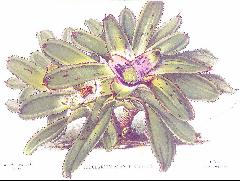
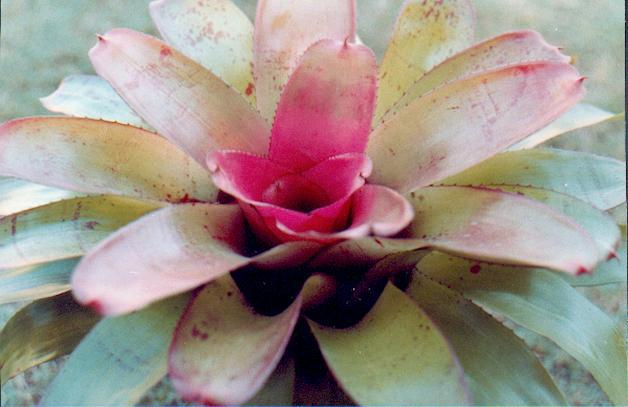
If we go back even further to the late 1950’s we find that Bill Morris also got seed from Adda of a Neo concentrica. Here he got ’normal’ species but one acted strangely in that it showed signs of variegation. He then moved to Cairns from Newcastle and left many plants behind. His contact in Melbourne at the time was Chas Hodgson and this could be the link to a report in the J. Brom. Soc in 1977 by John Nicol of a variegated concentrica in Australia. If this is the case then some 25 years of culling produced a stable albomarginate plant. Inevitably this plant got to the USA and just as inevitably it got reimported to Australia! By this time the Americans had started producing their own Neoregelia concentrica albomarginate but these had less leathery and narrower leaves suggesting that a hybrid with say N. carolinae involved. Regrettably so many hybrids are done without registering or even divulging parents so it is only a guess by Bill Morris as to why these imports were greatly different from his plant. So if you are after a true albomarginate form of N. concentrica, just ask around and make sure it has wide, leathery leaves!.
As for a normal N. concentrica, we think we have the true species although it is a bit clouded when you get ‘Select’ or ‘Super Select’ etc added to clones by nurserymen to sell their wares without really knowing if they have hybrid origin.
Now to hybrids. We know there are 3643 registered Neoregelia hybrids. We know that N. concentrica is involved in some 300 primary hybrids, 200 as seed and 100 as pollen parent. I do not know how many times it rates as a grandparent! What is the only other Neo species that surpasses this record? N. carolinae, of course, with 500 but it only took this position recently because of the variegated form which has been used ad nauseum as a seed parent.
When looking at hybrids it is a talking point to discuss what parents have the greatest influence on the progeny. This genetic link is taken to extremes by orchid fanciers with their hybrids where correct identification of parents is paramount. All other plant groups including Bromeliads accept possible wrong identification with the emphasis on identity of the cultivar not its parents. History tells us that in the Caribbean the English set up records to identify the slave population on the ratio of ‘black blood’ to ‘white blood’ and each of these greges had names. Nowadays it is just useless information. Perhaps they may have been better to work out the inter and intra breeding of a ‘white’ Englishman! If you have a computer you can ascertain for Orchid hybrids what percentage genes you have for a specific species in your hybrid. We know that few people can hybridise Orchids so their system may work for them. With Bromeliaceae there is always foreign pollen and everyone who grows from seed is a potential hybridist. Just one example is ‘Bobby Dazzler’ which started out by having the alleged parents of acanthocrater and proserpine. Do these names ring a bell regarding old names for N. concentrica?
So we had some interesting discussions but no conclusions. Many showed tell tale attributes you could link to N. concentrica such as ‘Big Mac’ and ‘Cliff Severd’ or even ‘Takemura Grande’. It was harder with the variegates such as ‘Chunky’ and ‘Gunpowder’, but ‘Orgy’ which has N. concentrica as a grandparent, there was no sign. If you aren’t growing ‘Orgy’ you may be growing its sister ‘Spot On’ which you may like to check to see if you see any N. concentrica in it?
While looking and seeing you were introduced to Neoregelia ‘Thor’ a handsome black leaved cultivar whose sister is xNiduregelia ‘Something Special’. The inquisitive may ask how this is so. Here is a clear case of different pollen fertilising the ovule next door. I wonder how the Orchid people deal with this?!
October 9th. This was the evening when Len Colgan ventured to Cherry Gardens to talk about Bromeliads to the local garden club. Perhaps he baffled them with science because he reported no banter from the audience. Perhaps too, he was baffled that it was not like our meetings at all. They did have ‘Show and Tell’ so Len learnt a lot about mulching, weeding, pruning and more mulching with a bit on vegetable growing. You never know but some inquisitive ones may venture down to the big smoke and pay us a visit on November 11th.
Neoregelia ‘Butternut’
In May 1994 on one of our many forays to the East Coast we acquired a plant from Bill Morris of Medowie, NSW that he had obtained with the name Neoregelia wilsoniana. Both of us had our doubts and considered it to be a hybrid with possibly N. wilsoniana as a parent. I promised to investigate further when it flowered in my collection. It duly flowered and I took photos from all angles. I even removed the inflorescence to help me in my search but the name N. wilsoniana hybrid stayed on the label. It was close to the species but how close? I got the ‘true’ N. wilsoniana also from Bill Morris and this was very close to the description and Foster’s drawing of the species. So we know this is in Australia for those who seek species rather than the plethora of hybrids that are around. When N. alvimii was treated as a synonym of N. wilsoniana in 1996 I had another look but dithered.
In recent years some of the larger herbariums in the USA have been scanning their specimens so the plebs can get access to these holy icons. This is also a good move because it means the dried plants are subjected to less handling and will stay intact for even longer. I chanced upon the herbarium specimens of N. wilsoniana and felt some decision had to be made. Margaret said that ‘Butternut’ was an apt name because of its yellow leaves in bright light so we will register it as such. It makes an ideal hanging basket. It is not to be confused with N. ‘Olly Wilson’ (wilsoniana x olens) which blushes red in the centre at flowering time.
If you think you have this plant and don’t want to dither, then please contact me so we can discuss identity.
